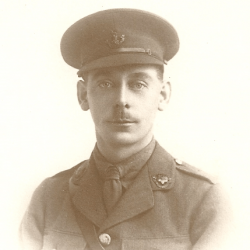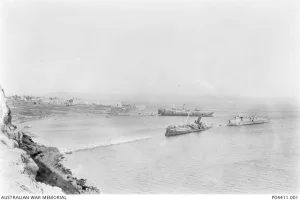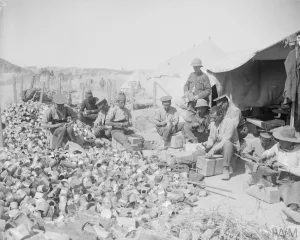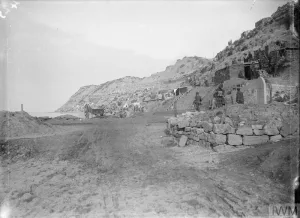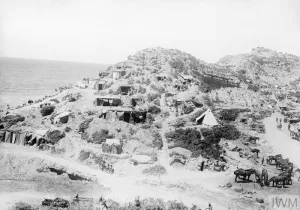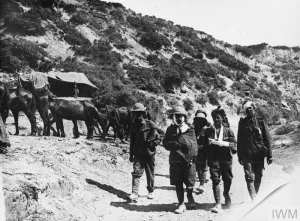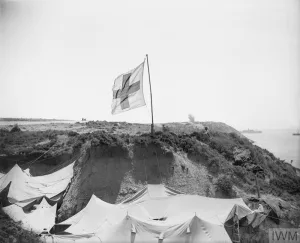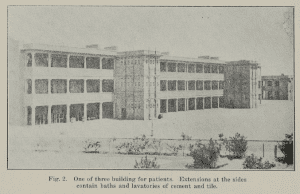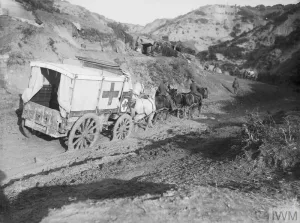Edwin Slater was born in Ashton-under-Lyne, Lancashire on April 13, 1892. In 1911 he was employed as an Iron Turner at Platt Brothers & Company in Oldham, as was his father. At this time, Platt Brothers had established itself as the world’s largest textile machinery manufacturer.
He is shown below in “early 1915”, (probably May 1915), taken from a group photo with his brother Arthur, of the 1/9th Battalion Manchester Regiment, and his sister Eleanor.
There are no Army service or pension records for Edwin; we only have his Medal Index Card, his 1915 Star Roll and his British War Medal and Victory Medal Roll entry.
His Medal Index Card (MIC) gives us his regimental number (22754) and tells us that he was in the 11th Battalion Royal Scots (Lothian) Regiment and that he was entitled to three medals: 1915 Star, British War Medal, and Victory Medal. It also tells us that his first date of entry of overseas deployment was August 11, 1915 to France. Finally, it indicates that he was demobilised on March 22, 1919 to the Class Z Reserve.
The Class Z Reserve was a Reserve contingent of the British Army consisting of discharged enlisted soldiers. The first Z Reserve was authorized by an Army Order of December 3, 1918 and was abolished on March 31, 1920 when the expected problems with violations of the Armistice did not materialize.
His 1915 Star Roll matches the information on his Medal Index Card (which is not always the case). The Star Roll is a crucial document because it also records all the other men of the 11th Battalion Royal Scots with the same disembarkation date as Edwin. By researching those men, several of whom have surviving service records we can deduce many things with a very high degree of certainty.
Below is a B.103 form from one of the men Edwin deployed with (Pte. DAVID CRIGHTON, 21179). It is identical to all of the surviving Service Records and it clearly shows their arrival in France and their assignments in the initial few weeks there.
Consequently, we know that Edwin Slater was part of a draft (the third draft) of at least 40 men who arrived at Boulogne on August 12, 1915. Almost all of these men attested and joined the Royal Scots in April/May 1915. Many of them attested at various locations throughout the UK and then traveled to Glencorse Barracks in Scotland joining the Royal Scots one or two days later. They went through basic training and then shipped out to France on August 11, 1918 arriving in Boulogne the next day. From there they were immediately assigned to the 5th Entrenching Battalion of the First Army. Entrenching battalions were temporary units and allocated at a Corps level. They were used as pools of men, from which drafts of replacements could be drawn by conventional infantry battalions.
Note: An analysis of the enlistment dates of the 10 men that joined the 11th Royal Scots with service numbers +/- 10 digits from his shows that he must have joined around May 10, 1915.
The following men were posted to the 11th Battalion Royal Scots, in the field, on September 18, 1915.
| Rank | No. | Forename | MI | Surname | Enlisted |
| Sgt | 10168 | THOMAS | A | PLIMER | |
| Pte | 13334 | THOMAS | CLOSE | 01-Sep-14 | |
| Pte | 16199 | DAVID | TAYLOR | ||
| A/Cpl | 20773 | JOHN | McMILLAN | ||
| Pte | 20899 | ROBERT | GUNN | 12-Mar-15 | |
| Sgt | 21053 | JOHN | NEILSON | ||
| L/Cpl | 21054 | ROBERT | FERGUSON | 07-Apr-15 | |
| Pte | 21056 | JOHN | BELL | ||
| Pte | 21116 | SAMUEL | WILLIS | ||
| Pte | 21117 | SAMUEL | TAGGART | ||
| Pte | 21118 | ANDREW | FUARY | ||
| Pte | 21128 | HUGH | O’DONNELL | 17-Apr-15 | |
| Pte | 21134 | WILLIAM | MYLES | 16-Apr-15 | |
| Pte | 21158 | HENRY | HAMMOND | ||
| Pte | 21159 | ANDREW | MILLER | ||
| Pte | 21173 | WILLIAM | GRANT | 22-Apr-15 | |
| Pte | 21179 | DAVID | CRIGHTON | 23-Apr-15 | |
| Cpl | 22691 | JOHN | HAWKINS | 29-Apr-15 | |
| Pte | 22721 | JOHN | BARLAS | 04-May-15 | |
| Pte | 22726 | THOMAS | KIRK | 22-Apr-15 | |
| Pte | 22754 | EDWIN | SLATER | ||
| Pte | 22764 | WILLIAM | BLACK | 12-May-15 | |
| Pte | 22776 | JAMES | FINNIGAN | 14-May-15 | |
| Pte | 22809 | W | GRAHAM | ||
| Cpl | 22814 | JOHN | E | BROOKS | 19-May-15 |
| Pte | 22826 | JOHN | BRADY | 17-May-15 | |
| Pte | 22933 | EDWARD | PEARSON | 27-May-15 | |
| Pte | 23023 | FRANK | C E | WILSON | 31-May-15 |
| Pte | 23409 | JAMES | CARR | 29-Jun-15 | |
| Sgt | 23656 | WILLIAM | H | PASCOE | 13-Apr-15 |
| Pte | 23664 | WILLIAM | E | SOUTH | 14-Apr-15 |
| Pte | 23685 | WILLIAM | R | WOOD | 08-Apr-15 |
| Sgt | 23698 | HENRY | W | DUNHAM | |
| Pte | 23708 | WILLIAM | J | BRASSETT | |
| Pte | 23709 | ALBERT | G | EVEREST | 15-May-15 |
| Pte | 23710 | ALBERT | R | GALE | 13-Apr-15 |
| Cpl | 23711 | ARTHUR | JONES | 12-May-15 | |
| Pte | 23715 | CRISTOPHER | R | PAUL | 17-Apr-15 |
| Pte | 23716 | SAMUEL | ROSS | ||
| L/Cpl | 23766 | ROBERT | McINTOSH |
On this date, the 11th Royal Scots were at Cambrin (near Bethune) and engaged in training, having recently been relieved in the line. They went back into the trenches on the 25th and were involved in a significant action between 25-28th in the opening phase of the Battle of Loos resulting in 381 Officers and Other Ranks killed, missing or wounded.
It is sobering to discover that of the 40 men listed in this draft, fully 17 would be Killed in Action and a further 8 would be discharged due to wounds or sickness and awarded the Silver War Badge. Two men won the Military Medal, one was Mentioned in Despatches and one man deserted.
Edwin Slater’s Service Medal and Award Roll entry also indicate that he at some point was transferred to the 16th Battalion Royal Scots Regiment.
The final piece of surviving information we have is the picture below (Edwin Slater is front row, right):
There is some indistinct writing on the photo but careful examination shows that it reads: “Loos 1915, Somme 1916, Ypres 1917, Arras 1917, Soissons 1918, Blicquy 1918, The Quarries 1918”. Also, at the bottom it says “5 Tanks, December 12, 1918”. This photo is a so called “survivors photo” taken after the Armistice with men about to be demobilised and celebrating their comradeship, service and, more importantly, their survival.
Military Medal
Edwin is wearing a medal ribbon:
The ribbon is for the Military Medal (MM) and Edwin Slater’s Military Medal (MM) was announced in the London Gazette on the 19th November, 1917 (and in the Edinburgh Gazette on 21st November 1917). The action for which it was awarded would have been some time prior to this publication date. The gazette, simply says “22754 Pte E. Slater, R. Scots (Ashton-under-Lyne)”.
Additionally, we have a short article in his local newspaper, the Ashton Reporter, regarding his award but unfortunately it provides no additional details except that it was published on October 20, 1917 a month before the official listing in the London Gazette.
Edwin’s Military Medal award was promulgated in the London Gazette of November 19, 1917. His was one of 5 MMs awarded to men of the 13th Royal Scots so it would appear that at some point he was transferred, or attached, to the 13th Battalion even though there is no mention of this on his medal roll.
At this time, the 13th Royal Scots were part of the 45th Brigade of the 15th Scottish Division. Edwin’s Registered Paper (No RP/68/121/327) indicates an award for 3rd Ypres. His schedule number (No 111419) indicates it was one of five 15th Division Military Medals awarded to the 13th Royal Scots.
The five MM awards, all from the 13/Battalion Royal Scots, were to:
16152 JAMES STEEL Schedule No 111417
20635 WILLIAM CARR Schedule No 111418
22754 EDWIN SLATER Schedule No 111419
37371 WILLIAM MULHOLLAND Schedule No 111420
15296 HENRY CHARLESON Schedule No 111422
The London Gazette of November 19, 1917 covers awards from July 27, 1917 to September 26, 1917. But we know that these awards were for gallantry on Wednesday August 22, 1917 in the 15th Division’s attack that day. The 15th Division’s 45th Brigade attacked Potsdam, Vampir and Borry Farms at 4:45am. Under the light of flares, the 13th Royal Scots’ and the 11th Argyll and Southern Highlanders’ attacking infantry was mostly wiped out by machine gun fire. Survivors fell back to establish a line from Railway Dump to Beck House. The 13th Royal Scots tried to get forward repeatedly throughout the day but were unsuccessful. Two German counter-attacks were beaten off with rifle fire and artillery. The 11th Argyll and Southern Highlanders were themselves awarded 4 Military Medals for the same action.
But we are getting ahead of ourselves …
11th Royal Scots
The 11th were attached to the 27th (Lowland) Infantry Brigade, of the 9th (Scottish) Division and moved to Bramshott in the Bordon area of Hampshire. In late April, 1915 whilst located at Bramshott, the Battalion received orders to move to the front and on the 11 May, 1915 the main body of men boarded the S.S. Invicta and crossed the English Channel landing at Boulogne, France later that same day.
The Battle of Loos (Sep 25 – Oct 15, 1915)
As already noted, the 11th Royal Scots, as part of the 9th Division of the First Army, fought in the front line during the opening phases of the Battle of Loos between September 25th to the 28th. Edwin Slater had been in France for just a few weeks and had arrived there after just a few short months of basic training. All of these newly arrived men were ill equipped to be thrust into the front line of a major offensive. From this draft of 40 men, Pte. WILLIAM BLACK (22764) was killed in action on the last day of the battle; less than a month after joining the Battalion in France. By the time it was over, the 9th (Scottish) Division had lost a staggering 6,058 casualties including 190 Officers.
Wounded in Action
After approximately 4 months of treatment and rest in the UK, Edwin returned to the front lines in France on February 1, 1916.
Two more men from this draft of 40 lost their lives in November and December 1915. Pte JOHN BARLAS (22721) was severely wounded in the face on November 11, 1915 and a week later was repatriated to the UK on the HM HS ANGLIA. Unfortunately, on November 17, 1915 the ANGLIA struck a mine and sank 1 mile off the coast of England, going down in just 15 minutes. 134 people drowned; Pte. BARLAS was one of them. Later, Private DAVID CRIGHTON (21179) was killed in action on December 12, 1915 while the 11th Royal Scots were once again in the front line.
The Battles of the Somme (Jul 1 – Nov 18, 1916)
The Somme was an Allied offensive that changed its nature due to the German attack against the French in the epic Battle of Verdun, which lasted from late February to November. Huge British losses were inflicted by the Germans on the first day followed by a series of fiercely-contested phases that became attritional in nature. September 15, 1916 saw the first-ever use of tanks in the phase known as the Battle of Flers-Courcelette. The British army in France was now approaching its maximum strength in numbers but was still developing in terms of tactics, technology, and command and control.
The British Fourth Army faced three separate very formidable German defensive systems of trenches, dugouts, underground shelters and deep barbed wire defences.
At this time, the 11th Royal Scots were in the 27th Brigade of the 9th (Scottish) Division attached to the XIII Corps of the British Fourth Army.
Somme: Battle of Albert, (1 – 13 Jul, 1916)
In this opening phase, the French and British assault broke into and gradually moved beyond the first of the German defensive systems. For the British, the attack on 1 July proved to be the worst day in the nation’s military history in terms of casualties sustained.
The 11th Royal Scots were in the reserve line moving up at 8pm on the 2nd to relieve the front line troops which was achieved by 3am on the 3rd. They remained in the front line suffering casualties every day from intense enemy shelling. Trenches were consolidated and patrols sent out until July 8th when they moved to Bivouac in the rear to rest and refit.
Somme: Battle of Bazentin, (14 – 17 Jul, 1916)
The 11th Royal Scots were in the front line and attacked the German line in the early hours of July 14th. They quickly achieved their first objective, capturing 63 German prisoners in the process, but their success came with a high cost of casualties. Three men from the draft of 40 lost their lives that day:
| Rank | No. | Forename | MI | Surname | Died |
| L/Cpl | 21054 | ROBERT | FERGUSON | 14-Jul-16 | |
| Pte | 22826 | JOHN | BRADY | 14-Jul-16 | |
| Pte | 23685 | WILLIAM | R | WOOD | 14-Jul-16 |
More frontal attacks of the German lines were undertaken by the 11th Royal Scots on the following days, as the 9th Division attempted to secure all their objectives of the initial attack. The Battalion was relieved from their front line duties at 8pm on the 17th July.
Wounded in Action Again
Pte. Edwin Slater (22754) Royal Scots was listed in the Daily Casualty List published in The Scotsman newspaper on August 24, 1916.
Generally speaking, it would take approximately one month from a soldier being wounded for them to appear in the casualty list. This was in part to allow the next of kin to be officially notified before finding it in the newspaper.
An analysis of the other men appearing in this Casualty List from the 11th Royal Scots shows that they were all wounded on July 14, 1916; the first day the 11th were in the line at the Battle of the Somme. As noted above, it could have been much worse.
In the November 11, 1916 edition of the Ashton Reporter Edwin is reported as having just been home on a 10-day furlough.
It was standard practice for soldiers wounded in action and repatriated to the UK to be awarded 10-days leave upon being fully discharged from hospital. So, this tells us that he was indeed repatriated to the UK and spent a little over 3 months in hospital before being discharged. Upon completing his leave he would then return to the regimental depot for a short period of light duty and this is borne out by the phrase in the newspaper “and has returned to Edinburgh” as the regimental depot was at Glencorse Barracks just south of Edinburgh. After some time at the depot he would then have been assigned to one of the regimental reserve battalions based somewhere in the UK. And finally, once he was deemed to be physically fit enough to return to active duty he would have been sent back to the front as and when needed.
Somme: High Wood
On the 18th October, when Edwin was finally being discharged from hospital in the UK, the 11th were back in the Somme front lines again, involved in actions to secure the feature known as The Butte de Warlencourt. The attack was undertaken under extremely difficult conditions of heavy rain, mud and intense cold, leading to large numbers suffering from exposure and trench foot in addition to considerable losses in action. Pte. JAMES FINNIGAN (22776) of the draft of 40 was wounded on the 20th, dying of those wounds on October 24, 1916.
For Edwin, 3 months in hospital being treated for gunshot wounds is not something anyone recovers from overnight so it’s likely he went through a 1-3 months recovery period in the UK after discharge before he had become fit enough for active duty and returned to France. So by March 1917 it’s likely that he was back in the thick of things.
Arras Daylight Reconnaissance (March 21, 1917)
By February 1917 the Allied Forces were planning and rehearsing the Arras Offensive which was scheduled to commence on April 9th. In March, intelligence was received that the Germans were withdrawing from certain positions and so Sir Charles Fergusson, (VXII Corps Commander), resolved to test the enemy’s strength in front of Arras by means of a daylight raid. The 11th Battalion Royal Scots were selected. The “raid” was a frontal assault on the German trenches carried out by approximately 200 men and resulted in a loss of 7 Officers and almost 70 Other Ranks killed, missing or wounded. Nevertheless, they had fulfilled their mission by proving that the Germans had in fact held themselves in full strength in their line opposite XVII Corps. Reports from the raid estimated that perhaps as many as 100 Germans had been killed or taken prisoner.
The efforts of the 11th Royal Scots that day elicited a letter of praise from the Third Army Commanding Officer.
Pte. WILLIAM SOUTH (23664) of the Draft of 40 also lost his life that day.
Now confident that the Germans had not withdrawn and were still at full strength, the Arras Offensive was put back into motion.
The Arras Offensive (9 Apr – 16 Jun, 1917)
The British were called upon to launch an attack in support of a larger French offensive: the battles of the Chemin des Dames and the hills of Champagne. The opening Battle of Vimy and the First Battle of the Scarpe were very encouraging, but once again the Offensive bogged down into an attritional slog.
The 11th Battalion moved into the trenches on April 4th and endured heavy shelling from the enemy resulting in 4 men killed and 7 wounded. One of the men killed that day was Pte. HUGH O’DONNELL (21128) from the Draft of 40.
The 13th Battalion Royal Scots
Frustratingly, we do not know exactly how or when Edwin returned to action after his wounds but his award of the Military Medal confirms that by August 1917 he joined, or was temporarily attached to, the 13th Royal Scots.
The 13th Royal Scots had a difficult time in April 1917. The war diary reports that when they were in the line from April 9-11 they lost 207 men killed, wounded or missing. They were back in the line from April 21-30 and lost another 261 men. That is close to half a Battalion. Consequently, they spent the next few months receiving replacements made up of men rejoining the Battalion, men who had served in France but with other Battalions and new recruits fresh from basic training with no prior fighting experience.
On August 7, 1917 fifty-six other ranks arrived, chiefly of men from the 11th Battalion and 5th and 6th Battalions. We have no way to be certain but it’s possible that Edwin was temporarily attached to the 13th Royal Scots via this draft. 458 men joined the Battalion in August and they were about to be tested under the most difficult of circumstances.
August 22, 1917
The action of August 22, 1917, took place in the Ypres Salient on the Western Front as part of the Third Battle of Ypres. The attack on 22 August, although unsuccessful, advanced the British front line up to 600 yards in places, on a two-mile front but failed to reach the more distant objectives it had been set.
On 17 August, the fresh and rested 15th (Scottish) Division relieved the 16th (Irish) Division in the XIX Corps area. In the 15th Division area, supported by patrols from the 47th (1/2nd London) Division south of the Ypres–Roulers railway, the 45th Brigade on the right was to attack behind four tanks, a creeping barrage and overhead fire from 32 machine-guns but the tanks ditched short of the front line on the Frezenberg–Zonnebeke road. As soon as the infantry advance began, German artillery-fire fell along a line from Frezenberg to Square Farm, followed by machine-gun fire on the attacking troops and on the support and reserve troops even before they left their trenches. The 13th Battalion, Royal Scots and the 11th Battalion, Argyll and Sutherland Highlanders were supported by the 6th Battalion, Cameron Highlanders. As soon as the advance began, German small-arms fire became so dense that runners could not go back or reinforcements move forward. Recognition flares were seen later at Potsdam, Borry Farm and Vampir Farm but nothing else was known of the progress of the infantry. Survivors retreated to join the 6th Camerons along the track running north-west from the Railway Dump to Beck House.
Machine-gun fire from the German fortified posts had devastated the infantry of the 15th (Scottish) Division as they struggled through the mud. A report from the 8th Seaforth described how the creeping barrage had failed to damage many pillboxes; the German defences had been underestimated and were insufficiently bombarded by the heavy artillery. The swiftness of the Germans in inflicting casualties left the survivors incapable of capturing strong points, even where the garrisons seemed willing to surrender.
The Official History of the Great War records that the 15th (Scottish) Division suffered 2,071 casualties; 1,052 casualties in the 44th Brigade and 1,019 in the 45th Brigade.
The following account, from the perspective of the 13th Royal Scots, is excerpted from The Royal Scots 1914-1919, by Major John Ewing, M.C. :
Owing to the bad weather, operations of any magnitude had to be postponed, but whenever there were any signs of improvement, attacks were launched. On August 16 our position was strengthened when we secured a hold on Langermark but after this operation rain set in again. The 13th Royal Scots, after their ordeal of July 31, 1917, were given a rest until August 20th when they took over the front line near Frezenberg, with their right flank on the Ypres-Roulers Railway. “D” and “B” were the two front companies with “C” in support and “A” in reserve. An attack, in which the 15th and 61st Divisions were to co-operate was arranged for 4:45am on August 22nd. The 13th Royal Scots, who went into action with Major Mitchell in command, formed the right Battalion of the Division, and their objective was a line extending from South of the railway to Bremen Redoubt, a fortified pill-box, exclusive. In view of the number of formidable pill-boxes to be encountered, special parties furnished by the Royal Scots Fusiliers and “A” and “C” companies of the Royal Scots were detailed to “mop up” particular points.
Most of the hostile shelling fortunately dropped behind the line of the assembled troops, but the attack, though carried out with the utmost gallantry, made little progress. Numerous Boche aeroplanes audaciously buzzed over our lines and inflicted several casualties on our men, who were met, moreover, by a terrific machine gun fire, particularly from the large pill-box known as Potsdam. The Royal Scots formed a line in front of Vampir and Potsdam and beat off several counter-attacks, but were unable to make any impression on the enemy’s defences. Ultimately, Major Mitchell established a new line from the railway, slightly in front of our original position, which the Royal Scots, in spite of a galling shell fire, including “shorts” from our own artillery, maintained without serious difficulty. Heavy losses were inflicted on the Boches by our rifle and Lewis Gun fire, on one occasion a party of sixty of the enemy being almost annihilated. Their exertions however, told heavily on the men, and they were very exhausted when on the night of the 22nd they were relieved and marched to a camp near Ypres.
The number of 13/Royal Scots casualties was again alarmingly high, (276 killed, wounded and missing including two officers killed), and as a result of the two actions in the salient practically a new Battalion had to be formed.
1918
We do not know what happened to Edwin between his winning the Military Medal in August 1917 to the end of the war but if we are to believe his Medal Roll at some point he transferred to the 16th Battalion Royal Scots from where he was demobilised. However, that does not seem to add up. The 16th Royal Scots were reduced to a cadre strength and attached to the 39th Division in May 1918 after suffering heavy casualties. They were finally disbanded in France on August 14, 1918 but we know that Edwin was not demobilised until early 1919.
As noted earlier, the writing on the above photo says “Loos 1915, Somme 1916, Ypres 1917, Arras 1917, Soissons 1918, Blicquy 1918, The Quarries 1918”.
Loos 1915, Somme 1916, Ypres 1917 and Arras 1917 all fit well with the battles fought by the 11th Royal Scots. Whereas, Soissons 1918 [23 July – 2 August 1918], The Quarries 1918 [12-16 Sept 1918] and Blicquy 1918 [Nov 11, 1918] fit well with the 13th Royal Scots.
It’s my belief that Edwin’s Medal Roll is wrong and instead of the 16th it should actually say 13th – but this is pure conjecture on my part.
Class Z Reserve
Pte. Edwin Slater was demobilised to Class Z reserve on March 22, 1919.
The Class Z Reserve was authorised by an Army Order of December 3, 1918. There were fears that Germany would not accept the terms of any peace treaty, and therefore the British Government decided it would be wise to be able to quickly recall trained men in the eventuality of a resumption of hostilities. Soldiers who were being demobilised, particularly those who had agreed to serve “for the duration of the War”, were at first posted to Class Z. They returned to civilian life but with an obligation to return to military service if called upon. The Z Reserve was abolished on March 31, 1920.
Royal Visit to Ashton-under-Lyne May 20, 1938
Edwin was presented to King George VI and Queen Elizabeth when they visited Ashton on May 20, 1938 at the very end of their 4 day tour of Lancashire.
Not only was he presented to the King and Queen, he also had the honour of accompanying them when they briefly met with some of the disabled ex-servicemen of Ashton, as can be seen in the photo below.
LAST POST
Edwin Slater died in Ashton-under-Lyne, Lancashire on November 23, 1945. He was 53 years old.
References
The History of the 9th (Scottish) Division, 1914 – 1919
Major John Ewing, MC
The Royal Scots, 1914-1919, Vol I 1914 – May 1919
Major John Ewing, MC
The Royal Scots, 1914-1919, Vol II May 1917 – May 1919 and Appendices
Major John Ewing, MC

